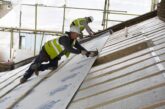
Embrace the solar revolution with Sandtoft in-roof solar
The housebuilding sector is gearing up for a major change with the introduction of the Future Homes Standard in 2025. Simon Garbett, Category Manager Roof Systems at Wienerberger UK & Ireland, explores how housebuilders can take advantage of the solar revolution and how Wienerberger is ready to support in creating more energy-efficient homes for the future.
Surging demand for solar
Solar is booming right now, with small-scale residential solar panel installations accounting for 73% of the UK’s added solar capacity in 2022(1). More than 60,000 installations were completed in Q1 2023, the highest-performing quarter since Q4 2015(2). The number of MCS certified contractors is on the rise too; in just 12 months, the count of solar PV contractors has risen by 66%.
This shift towards renewable energy sources is driven by lots of factors, such as a greater demand for energy security and reducing bills. The other driver is, of course, changing Building Regulations in the housebuilding sector. The introduction of the Future Homes Standard in 2025 will mean that new homes must be “future-proofed with low-carbon heating and world-leading levels of energy efficiency.”(3) The roll out of the updated Part L Building Regulations last year marked the first transitional step towards this. These new regulations require new homes to produce 31% less CO2 emissions compared to previous standards.

One key aspect of the new regulations is the emphasis on a ‘Fabric First’ approach, with a shift towards high-performance and efficient materials that minimise energy consumption. Yet ‘Fabric First’ alone may not be sufficient to meet the standards. Integrating cutting-edge technology to enable homes to generate and store their own energy will play a pivotal role in achieving the UK’s energy goals.
Increasing housebuilder support
At Wienerberger, we have been innovating our product offering to make sure our customers can meet the growing demand for energy efficient solutions. We launched our Sandtoft in-roof solar range earlier this year, which marked a huge step for us in expanding on the fabric and technology options we offer.
The integrated solar roof panels have been designed with our housebuilder and roofing customers in mind. Each panel features an interlocking design and attaches directly to the roof batten to speed up the installation process. They are fully compatible with clay and concrete tiles.
Full roof system approach
In new build projects, we are seeing a significant duplication of effort when it comes to installing solar. First, the roofer installs the felt and timber batons, followed by the solar installer fitting the panels. The roofer returns to fill the gaps around the solar system. Finally, the solar installer adds the inverter and connects it to the grid during. This disjointed process poses a risk, as there’s no clear ownership of the installation itself, making it challenging to address potential issues effectively.

This is why it’s critical that housebuilders feel empowered to become more experienced in owning that whole process through one key roofing contact. We’re starting to see this very small balance shift with contractors who are starting to offer this full roof solution. We are also now adapting our solar range to meet this demand by offering a complete solar system package that includes inverters and batteries, which we’ll be rolling out in the coming months – a step which we hope will help support those contractors looking to themselves to offer the full solar solution.
Training and accreditation
We’re working hard to encourage housebuilders and roofers to upskill, learn more about solar and how it can benefit their business. At Wienerberger, we offer certified on demand product training to support roofers upskilling to install solar PV on their journey.

Unlocking opportunities for housebuilders
From 2025, homes built in the UK will produce 75-80% less carbon emissions than homes built under current Building Regulations. There is no doubt that a huge effort is needed across the industry to achieve this: from roofing and insulation contractors to builders and heating engineers. Training, education and partnership working will be vital, manufacturers themselves have the opportunity to play a significant role here. Government, too, can help upskill the workforce, particularly when it comes to determining how we can fund and train apprentices who will have a crucial part to play in shaping the next generation of contractors.
With the range of solutions set to become a part of the mix – from heat pumps to insulation – no one initiative on its own is the answer. The future will see homes relying on a much more holistic mix of solutions as well as how we source that energy. So, keep abreast of innovations beyond that in your own sector; read up on wider initiatives so that you can work with other trades. This will be of particular importance on retrofit projects where trades will be expected to have a grasp on the bigger picture to advise their customers.

Find out more about Wienerberger’s Sandtoft in-roof solar at https://www.wienerberger.co.uk/products/roof/in-roof-solar.html.
To find out more about Wienerberger’s certified on demand product training visit On Demand In-Roof Solar Training | Wienerberger UK.
1 https://www.energylivenews.com/2023/07/05/exclusive-uk-adds-73-of-solar-capacity-from-households/
2 https://mcscertified.com/latest-mcs-data-reveals-continued-demand-for-small-scale-renewables-in-uk-home/
3 https://www.gov.uk/government/consultations/the-future-homes-standard-changes-to-part-l-and-part-f-of-the-building-regulations-for-new-dwellings







